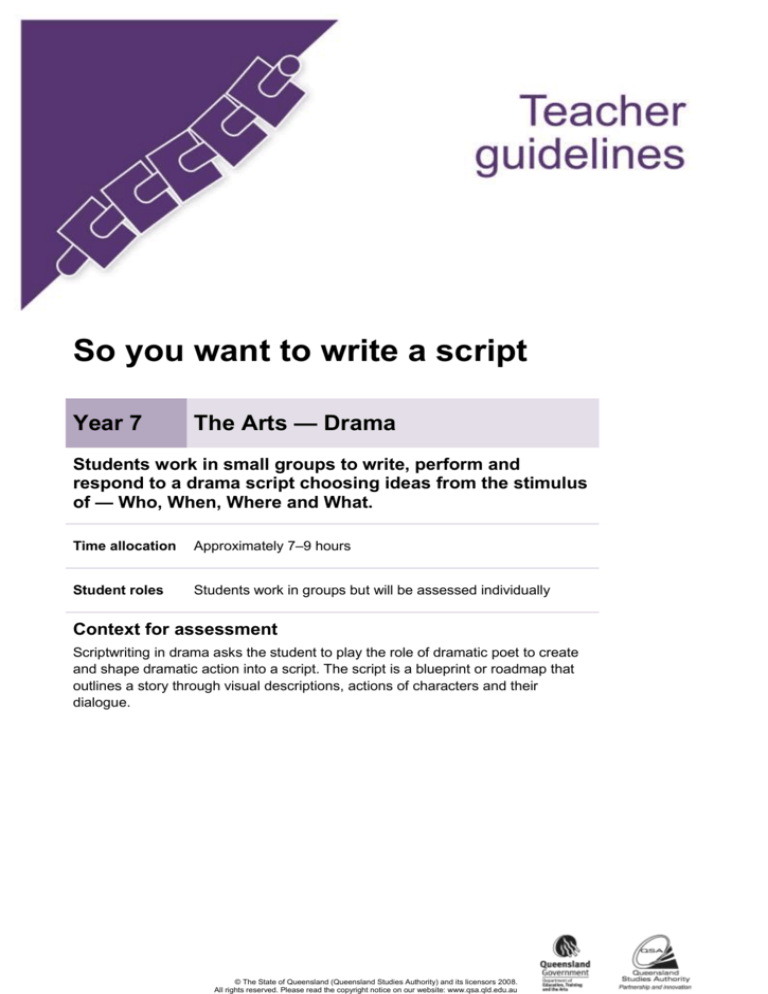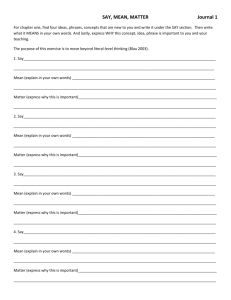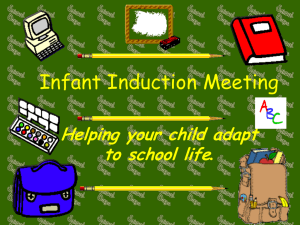
So you want to write a script
Year 7
The Arts — Drama
Students work in small groups to write, perform and
respond to a drama script choosing ideas from the stimulus
of — Who, When, Where and What.
Time allocation
Approximately 7–9 hours
Student roles
Students work in groups but will be assessed individually
Context for assessment
Scriptwriting in drama asks the student to play the role of dramatic poet to create
and shape dramatic action into a script. The script is a blueprint or roadmap that
outlines a story through visual descriptions, actions of characters and their
dialogue.
© The State of Queensland (Queensland Studies Authority) and its licensors 2008.
All rights reserved. Please read the copyright notice on our website: www.qsa.qld.edu.au
Teacher guidelines
This assessment gathers evidence of learning for the following Essential Learnings.
The Arts
Essential Learnings by the end of Year 7
Ways of working
Knowledge and understanding
Students are able to:
Drama
select and develop ideas for arts works,
considering intended audiences and
intended purposes, and make decisions
about arts elements and languages
create and shape arts works by
modifying arts elements to express
purpose and to include influences from
their own and other cultures and times
Drama involves modifying dramatic elements
and conventions to express ideas, considering
intended audiences and intended purposes,
through dramatic action based on real or
imagined events.
modify and polish arts works, using
interpretive and technical skills
present arts works to informal and
formal audiences for intended
purposes, using arts techniques, skills
and processes
identify, apply and justify safe practices
respond by analysing and evaluating
arts works in social, cultural, historical
and spiritual contexts, using arts
elements and languages
reflect on learning, apply new
understandings and identify future
applications.
Roles and characters can be presented from
different perspectives and in different
situations, using variations in voice, movement
and focus.
Purpose and context are considered when
modifying mood, time frames, language, place
and space, and are used to express ideas.
Dramatic action is interpreted, prepared and
shaped through scenarios and scripts.
Assessable elements
Knowledge and understanding
Creating
Presenting
Responding
Reflecting
Source: Queensland Studies Authority 2007, The Arts Essential Learnings by the end of Year 7, QSA, Brisbane.
2
Year 7 The Arts — Drama: So you want to write a script
Links to other KLAs
This assessment could be expanded to assess the following Essential Learnings.
English
Essential Learnings by the end of Year 7
Ways of working
Knowledge and understanding
Students are able to:
Writing and designing
identify and demonstrate the
relationship between audience, subject
matter, purpose and text type
construct literary texts by planning and
developing subject matter, using
dialogue, description and evaluative
language.
Writing and designing involve using language
elements to construct literary and non-literary
texts for audiences across wider community
contexts.
The purpose of writing and designing includes
evoking emotion, persuading and informing.
Writers and designers establish roles, make
assumptions about their audience and position
them through language choices.
Words and phrases, symbols, images and
audio affect meaning and position an
audience.
Language elements
Interpreting and constructing texts involve
selecting and controlling choices about
grammar, punctuation, vocabulary, audio and
visual elements, in print-based, electronic and
face-to-face modes (speaking and listening,
reading and viewing, writing and designing)
across wider community contexts.
Vocabulary is chosen to establish
relationships, persuade others, describe ideas
and demonstrate knowledge.
Literary and non-literary texts
Evaluating literary and non-literary texts
involves understanding the purpose,
audience, subject matter and text structure.
Literary texts entertain, evoke emotion, create
suspense and convey messages and
information.
Characters with feelings and personalities
beyond those of traditional characters are
explored in texts by selecting vocabulary and
using descriptions, imagery, actions and
dialogue.
Descriptions, actions and dialogue, using
written and visual elements, develop
characters and plot.
Source: Queensland Studies Authority 2007, English Essential Learnings by the end of Year 7, QSA, Brisbane.
3
Teacher guidelines
Listed here are suggested learning experiences for students before attempting this assessment.
Collaborate with others to structure drama by applying knowledge of drama elements —
character, place, time frame, language and mood.
Model and create scripts using basic conventions and layout.
Look at published scripts as examples of structuring dramatic action.
Develop scenes from selections of Who, When, Where and What options to structure dramatic
action.
Use improvisation (e.g. hot-seating, role on the wall, freeze frames to develop characters,
scenes and ideas). See Appendix A: Drama improvisation ideas.
Develop character profiles to outline character traits and details.
Refine and polish interpretive and technical drama skills — movement (body language and
gesture) and voice (pitch, pace, pause, volume and tone).
Participate in discussion about drama — analyse, evaluate and reflect on use of drama
elements.
Reflect by writing and talking about dramatic action.
Gain awareness of appropriate audience etiquette (see Appendix B: Audience etiquette).
Suggest ways to improve your own and others’ use of drama skills and elements.
Develop and display sensitivity in critiquing others’ work by using appropriate drama
languages.
Teacher resources
Adventuring into drama: A dramatic English book for secondary students, Cheung, M 2006,
Dramatic English Ltd, Hong Kong.
Dramactive book 1, Stinson, M & Wall, D 2003, McGraw-Hill, Australia.
Celtx scriptwriting software is free to download and has free online support: <www.celtx.com>.
Note: The projects shown the “Project central” section of the Celtx website may contain material
that is not appropriate for young people.
4
Year 7 The Arts — Drama: So you want to write a script
Preparing
Consider these points before implementing the assessment.
Remind students of the appropriate audience etiquette. Discuss and model sensitivity to
ensure that students reflect on the performances of others’ in a suitable manner and tone.
Use the Y-chart graphic organisers in Appendix B: Performance and audience etiquette, or
brainstorm more ideas to encourage students to think critically about achieving a positive
classroom environment for drama, and to identify appropriate behaviours using aspects of
looks like, sounds like and feels like.
Provide a suitable uncluttered area for rehearsals and performances.
It is vital to do vocal warm-ups before performing to avoid vocal strain during performance. It is
also useful to do some warm-ups before any rehearsal to help performers focus on the task
that follows. See Appendix C: Vocal and physical warm-ups.
The teacher may supply a costume box of basic items (e.g. jacket, shirt, tie, hat, cap) to help
students feel more in role, but only the vocal and movement qualities are to be assessed.
Implementation
Consider these points when implementing the assessment.
Monitor group work carefully to ensure that all students are contributing and developing ideas
towards the script, scriptwriting and rehearsal.
Hot-seating is a good way to help students develop their character profiles. The teacher and
the class question or interview a student sitting in front of them. The interviewee acts as if they
were the character they have developed — they will be “in-role” for the interview.
Adapting this assessment to suit other KLAs
The Who, When, Where, and What stimulus sheet from this assessment could be adapted to
include features of another text. For example, students could use a novel or text from an English or
SOSE unit to script a chapter and discuss the characters, time, place and situation relevant to that
chapter.
The Assessable elements of a character profile, script, reflection and performance could still be
undertaken. Teachers would need to clarify audience and purpose for the assessment.
5
Teacher guidelines
Sample implementation plan
This table shows one way that this assessment can be implemented. It is a guide only — you may
choose to use all, part, or none of the table. You may customise the table to suit your students and
their school environment.
Suggested time
Student activity
Teacher role
Section 1. Create a drama story
1 hour
Students work in groups of 3–4 to plan
their drama story using the Who,
When, Where and What stimulus,
Script ideas and Drama structure
planning sheets in the Student booklet.
Students work individually to develop a
character profile.
Monitor and guide group selection.
Guide and assist groups as needed in
their oral and written planning.
Assist students in developing their
characters by conducting an improvisation
exercise (see Appendix A: Drama
improvisation ideas).
Students participate in hot-seating or
other improvisational activities to
develop a deeper understanding of
their character.
Section 2. Write a group script
2–3 hours
Students work as a group to write the
script for their drama story.
Reinforce scripting conventions given in
Student booklet.
Each student contributes one page of
dialogue — a scene or section of the
script.
Monitor group work to ensure that each
student is contributing a section of work.
Section 3. Perform the group script
3–4 hours
Students concentrate on movement
and voice skills using the Actor’s
checklist in the Student booklet to
guide rehearsal and improve skills.
Organise feedback opportunities during
the rehearsal phase.
Students rehearse, refine and polish
their script to performance level.
Reinforce etiquette and warm-up (see
Appendix B: Performance and audience
etiquette & Appendix C: Vocal and
physical warm-up).
Students perform their work without
scripts.
Consider audience location in the space
to be used for performances.
Video the performances to play back for
student viewing and informal discussion.
Section 4. Reflect on scripts
1 hour
Students complete a reflection on their
own scripts and the performances and
scripts of other groups.
Resources for the assessment
Appendix A
Drama improvisation ideas
Appendix B
Performance and audience etiquette
Appendix C
Vocal and physical warm-up
6
Guide and assist as needed.
Year 7 The Arts — Drama: So you want to write a script
During the learning process, you and your students should have developed a shared
understanding of the curriculum expectations identified as part of the planning process.
After students have completed the assessment, identify, gather and interpret the information
provided in student responses. Use only the evidence in student responses to make your judgment
about the quality of the student learning. Refer to the following documents to assist you in making
standards-referenced judgments:
Guide to making judgments
Indicative A response
Sample responses (where available).
Making judgments about this assessment
Monitor group work carefully to ensure that all students are contributing and developing ideas
towards the script, scriptwriting and rehearsal. The planning sheets will provide valuable evidence
of individual contributions and video documentation will provide evidence to support making
judgments about student performance.
For further information, refer to the resource Using a Guide to making judgments,
available in the Resources section of the Assessment Bank website.
7
Teacher guidelines
Evaluate the information gathered from the assessment to inform teaching and learning strategies.
Involve students in the feedback process. Give students opportunities to ask follow-up questions
and share their learning observations or experiences.
Focus feedback on the student’s personal progress. Emphasise continuous progress relative to
their previous achievement and to the learning expectations — avoid comparing a student with
their classmates.
Giving feedback about this assessment
Provide feedback on the different processes of creating, presenting, responding and reflecting on
drama. This may be given individually to particular students, to small groups or to the whole class
group as particular needs are identified.
When students are providing feedback to each other, it is important to encourage sensitivity and
the use of appropriate drama language.
For further information, refer to the resource Using feedback, available in the
Resources section of the Assessment Bank website.
8
Appendix A
Drama improvisation ideas
Freeze frames
A series of frozen actions or pictures from
a situation or story that can be presented
by a small group of students to the rest of
the class. The watching students close
their eyes while the presenting group
prepares each frame. On a signal from the
teacher, the watchers open their eyes and
observe each frame, which is held for
about five seconds. A sequence of about
three frames is needed to convey the
action or story.
Hot-seat
The teacher or student in role sits in an
agreed location and is interviewed or
questioned by the participants in the
drama. The person in the hot-seat can
question and challenge the participants.
Role on the wall
Information about a character or
characters from the drama is written within
and outside the blank outline of a figure.
The information inside is related to the
character’s feelings and ideas, while the
information on the outside of the figure
relates to appearance, actions or what
others say about them.
Appendix B
Performance etiquette
Looks like …
actors showing movements
and voice suitable for their
character
blocking and movement
around stage considered.
Sounds like …
Feels like …
exciting, worthwhile, valued
motivated, engaged,
cheerful, happy
comfortable in performing,
purposeful, satisfying.
lines committed to
memory
listening to positive
comments and praise.
Audience etiquette
Looks like …
people watching attentively
everyone quiet and respectful
sitting focused, looking
towards performers.
Sounds like …
Feels like …
quiet during performance
everyone is valued
praise and encouragement
with clapping at end of
performance
worthwhile contributions by
all students
positive, respectful
comments.
motivated, engaged,
interested audience
performers trying their best.
Appendix C
Vocal and physical warm-ups
It is vital to do these vocal and physical warm-ups before performing. They will help you avoid vocal or
physical strain during the performance. It is also useful to do some warm-ups before any rehearsal to
help you focus on the task that follows. Daily practice with these exercises will improve your vocal and
physical flexibility.
Only do those exercises that you have already experienced in class.
Vocal
One of the most important things to do to maintain good vocal health is to keep your vocal chords
lubricated. When you are rehearsing, performing, or just doing a lot of talking, keep water nearby and sip
it as often as you can. Don’t let your vocal chords dry out.
Clarity of speech can be helped by exercises and tongue twisters. It is important to try to make the
sounds as clearly and quickly as possible. Try these:
Divide the group into four. Each sub-group takes a turn at the following phrases:
boom
boom
boom
boom (keeping a steady beat)
baba
baba
baba
bah
dah digga
digga digga
digga digga
dah
shika tika
shika tika
shika tika
shah
Look around the space and name everything you see with its real name. Then give them gibberish
names such as “blof” for clock.
Choose a phrase to “speak” silently. Open your mouth wide and exaggerate the articulation so
observers can guess the phrase.
Give a “silent” scream.
Breathing and projection
The basis of all voice projection is breathing and breath control. Follow these steps:
Lie on your back on the floor. Rest your hands lightly on your diaphragm (just above your stomach).
Breathe in, trying to fill the lowest part of your lungs. Feel your diaphragm working.
Breathe in for three counts; hold for three counts; breathe out for three counts.
With soft knees, bend forward from the hips, keeping a nice, straight back, and breath in and out.
Breathe out as much as you can. Holding your nose, scrunch as small as you can then release your
nose and slowly stand up, allowing the vacuum to pull air back into your lungs.
Walk for three counts and on the third count jump and say “Ha!”
To gauge how your capacity and control have improved, choose a fixed spot some distance away
from where you are standing and count how many times you can clearly speak the letters of the
alphabet, projecting your voice to that spot.
Physical
Physical warm-ups help you avoid tension in workshops and performance. Try these:
A gentle body roll. Start in neutral stance. Gradually, and in turn, push your knees forward, then your
hips, then stomach, chest, nose. Go back to the knees and establish a gentle pattern and rhythm.
Repeat above and freeze in one position. Carry this position through to a walk around the room.
Exaggerate the posture and add a letter of the alphabet to develop a voice for this character walk,
e.g. a stomach person may walk with a big, round “O” sound, and a nose person may use “E”.
Milk carton volleyball. Hit a milk carton up into the air and see how many hits the group can count
before the carton drops to the floor.
Let your little light shine. Start in neutral stance. Pretend you have little lights on different parts of
your body and shine those lights in little, slow circles. Use your big toes, knees, fingertips, shoulders,
elbows, nose and so on. Change the direction of the circles.
Fixed point. Choose a fixed point somewhere in the room. Run around the room and, when the
leader calls a part of the body, freeze and point that part of the body to the fixed point. It may be right
knee, left elbow, forehead, and so on.
Adapted from “Warm-ups: Student resource 4”, The Arts — sourcebook modules, The Office of the Queensland School Curriculum
Council 2002.





